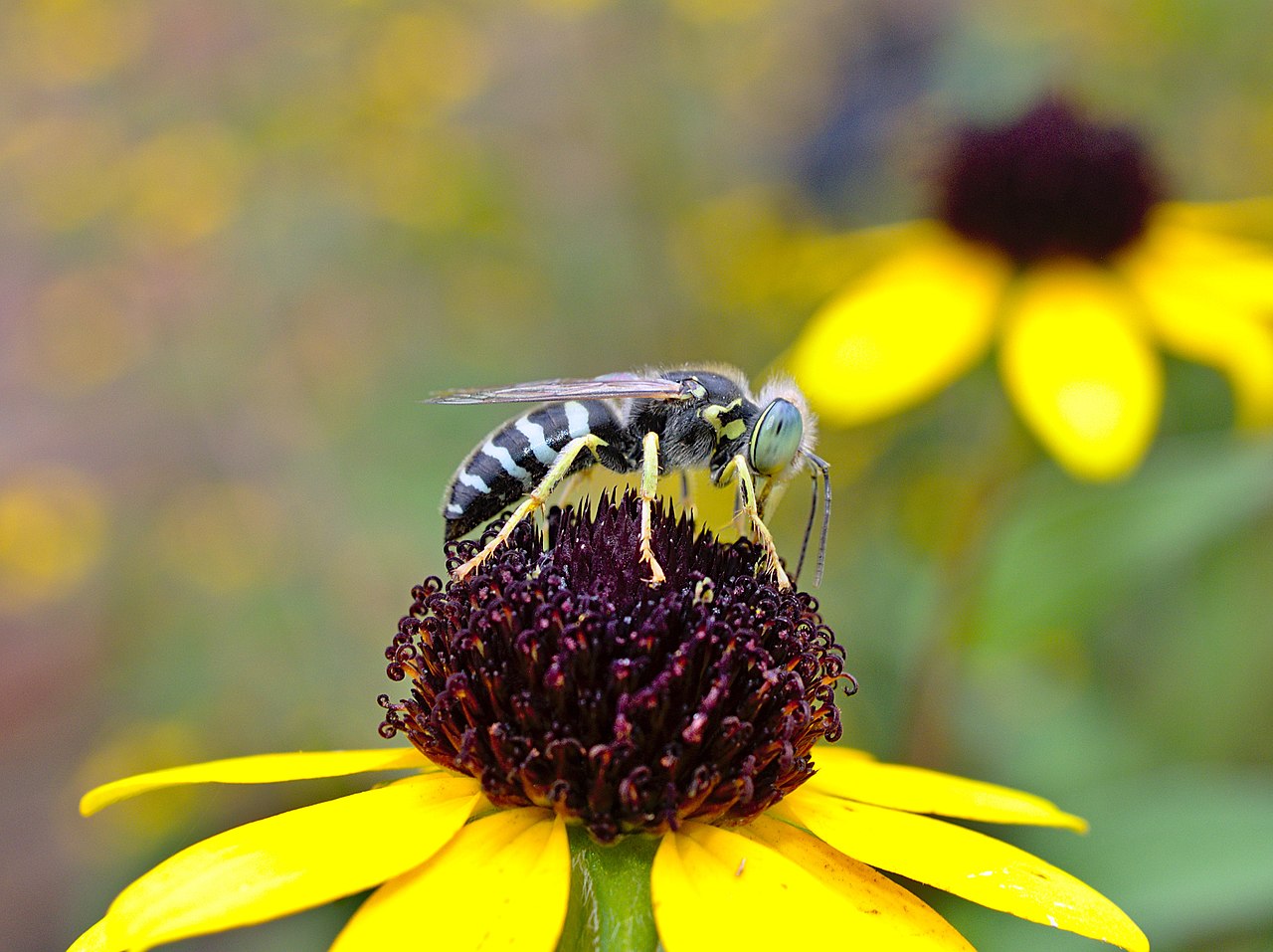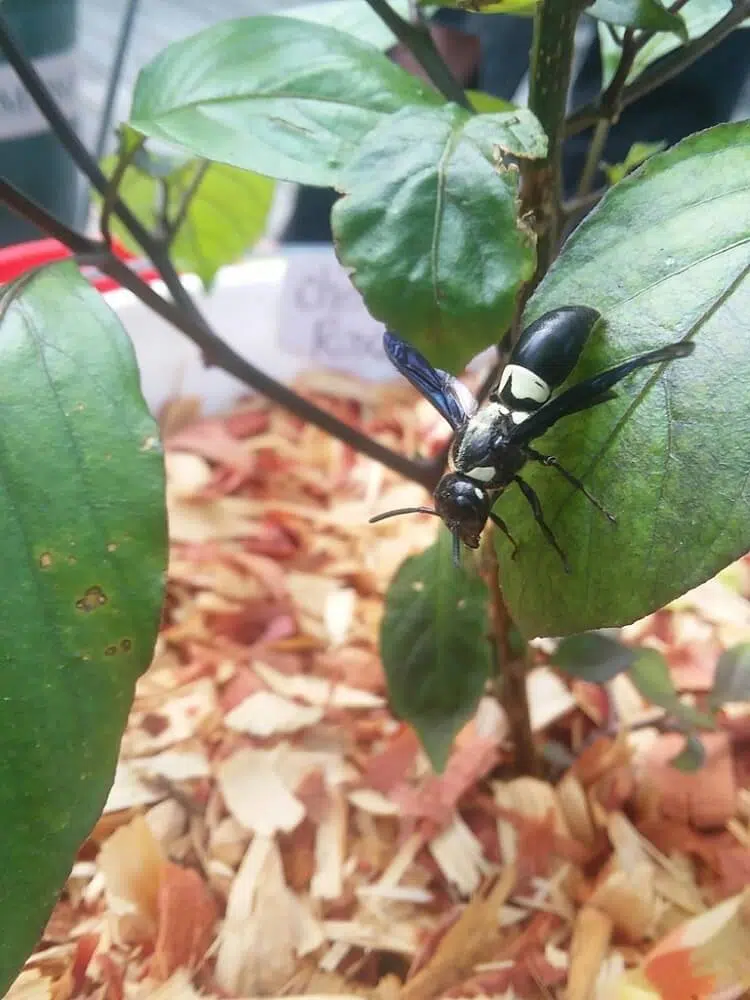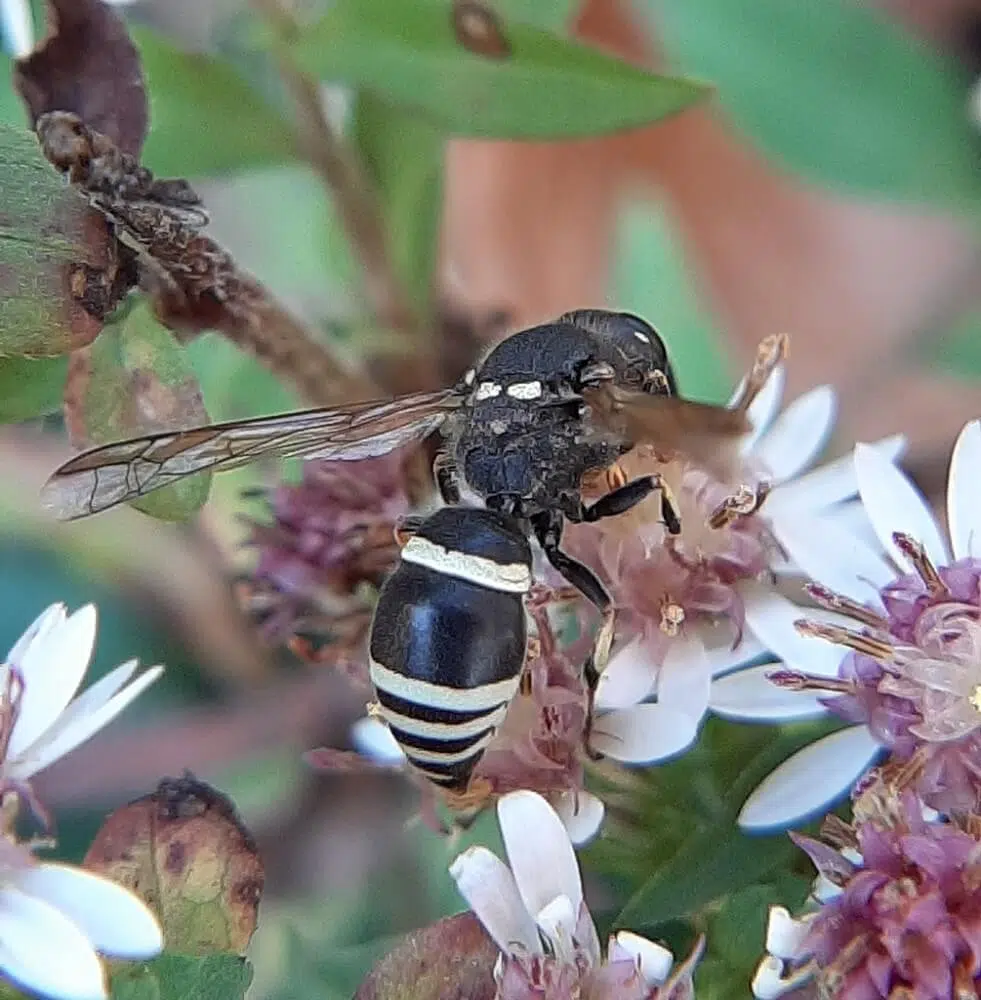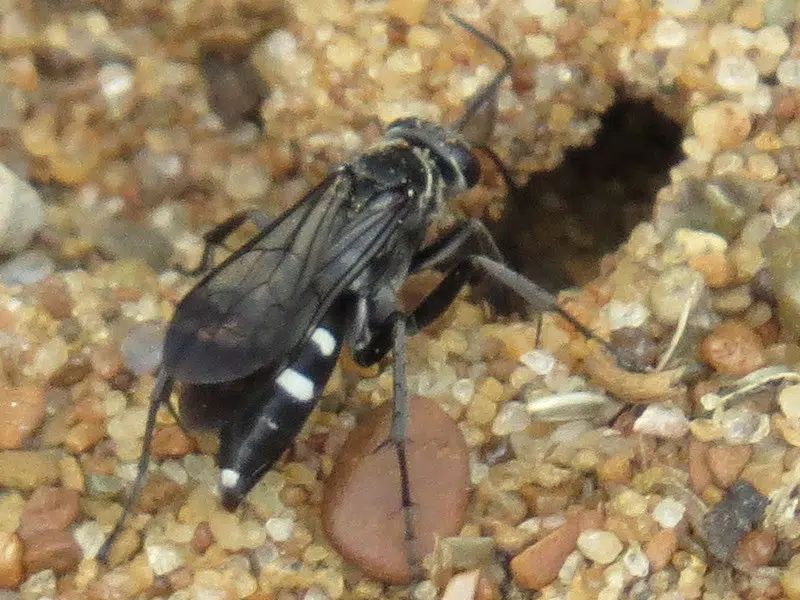Black and white wasps are common around the US.
They are seen in states such as Texas, New Mexico, Louisiana, and Arizona.
Some of these wasps can be dangerous.
The sting of these wasps can be painful and it can also last a few hours or even a couple of days. It can also trigger allergic reactions.
Wasps that are black and white are somewhat atypical as many associate wasps with black and yellow color, similar to the appearance of the common Yellowjacket wasp.
Table of Contents
Are Black and White Wasps Dangerous?
Black and white wasps can sometimes be dangerous to humans.
They can sting if under threat and this sting can come with venom.
The result is a highly painful bite with very high levels of pain which may last around 24 hours.
Black and white wasps can also have a barbed stinger which is also painful to remove when stuck in the skin.
Black and white wasps can also be beneficial for farmers. Some of these wasps are known parasites of moths such as fruit-eating moths.
Types of Black and White Wasps
The following species of Black and White wasps are common in North America. Some of them are also found around the world.
1. Bald-faced Hornet

Bald-faced Hornets (Dolichovespula maculata) are a common black and white wasp with a name inspired by their appearance.
The white head or the bald heat of these wasps inspires their name.
The wasps also have horizontal black lines on their abdomen.
Bald-faced Hornets also build white paper-like nests.
These nests are always seen above the ground and can sometimes be found attached to man-made structures.
Bald-faced Hornets might not be as aggressive as other wasps but they still live similar social lives led by a queen.
The queen Bald-faced Hornet lays almost all initial eggs in a nest.
2. Four-toothed Mason Wasp

The Four-toothed Mason Wasp (Monobia quadridens) has a mostly black body with 3 white stripes.
Wasps of this genus resemble large flies and can be further distinguished by their long black wings.
Four-toothed Mason wasps have a wingspan of at least 14mm.
Females of the species can sting.
While the sting itself isn’t venomous, it’s still painful.
The pain level of the Four-toothed Mason wasp sting is comparable to the pain levels of the Bald-faced Hornet sting.
These wasps are common in the US. New Mexico is one of the states with the highest number of Fou-toothed Mason wasps
3. Fraternal Potter Wasp

Fraternal Potter Wasps (Eumenes fraternus) are very popular wasps due to their use of mud to create a safe space to lay eggs.
These wasps are also popular due to their shape alongside having a black and white-ivory color.
Fraternal potter wasps have an elongated abdomen that widens towards the rear.
Wasps of this genus are known for creating individual small mud pots to lay one egg in.
It can take a few hours for dirt and water to be mixed and to create such a pot.
Once ready, the Fraternal Potter wasp lays an egg inside together with some type of food which is an insect or the larvae of an insect.
The mud pot is then closed by the wasp until the egg hatches.
4. Double-banded Scoliid Wasp

The Double-banded Scollid Wasp (Scolia bicincta) is a black and white species believed to mimic the Mason wasp.
2 white bands are seen on the abdomen of this species which has a black body with black wings, and black legs.
Common in Northeastern parts of the US, these wasps are seen as beneficial even if the females can sting.
The female Double-banded Scoliid wasp has a retractable stinger.
These wasps are beneficial in gardens as they carry and eat a large amount of pollen from one flower to another.
Seen as a pollinator species, the Double-banded Scoliid wasp can be seen as a large species compared to other black and white wasps.
The body length of the Double-banded Scoliid Wasp ranges from 15 to 25mm.
5. Pseudodynerus quadrisectus

This family of wasps is also known for its black and white appearance.
A black body with 4 white lines characterizes the appearance of the species.
Wasps of this genus are considered solitary which means they don’t build nests and they are rarely seen in groups.
They are also known as a species of mud wasps as they build small mud chambers for their eggs and the emerging larvae.
These mud chambers or containers are made using pure soil and water drops the wasp’s mix and shapes to create a container-like chamber.
This black and white species is common in the US, particularly in the Eastern states.
6. Euodynerus Megaera

Wasps of this genus have a black background color, 2 white stripes on the abdomen, a small central mark, and a white stripe behind the head.
Its wings, antennae, and legs are also black.
These wasps are solitary and are known pollinators.
They feed on pollen as adults and can carry a large amount of pollen on their bodies.
These wasps are common in Eastern and Northeastern parts of the US.
Its habitat is closely tied to the flowers it visits. This wasp species is known for living around Aquatic milkweed.
It also eats the pollen of various other wildflowers such as Scarlet beebalm flowers.
The wasp can be seen on these flowers during the day as a diurnal species.
7. American Sand Wasp

The American Sand Wasp (Bembix Americana) is common in the US and Mexico.
Wasps of the species grow to a size of around 20mm and can be identified by the black and white colors and the large compound eyes at the sides of the head.
The thorax of the wasp is black while its abdomen has black and white stripes.
The head, thorax, and abdomen are all covered in short white hairs.
American Sand Wasps don’t have black wings like other black and white wasps as they have long brown transparent wings.
The legs of the American Sand Wasp are yellow. They can be pale yellow or solid yellow.
These wasps aren’t as dangerous as others as they cannot sting.
8. Blackjacket

Blackjacket Wasps (Vespula consobrina) are found all over North America. They are seen even in Canada, but not in Alaska.
These wasps have a black body with white marks on the head and the thorax. They also have white stripes across the abdomen.
The species exhibits brown wings and red-brown legs with white marks.
Living underground, Black jackets are wasps with clear hierarchies. They have a queen, a worker caste, and male wasps.
Male Blackjacket wasps are identified by the white marks on their heads.
These marks make the male Blackjacket similar to Bald-faced hornets.
Male wasps also have short white hairs on the thorax and the abdomen.
Blackjacket wasps aren’t very dangerous to humans.
These wasps are only aggressive when they live in large colonies.
Blackjackets can be aggressive toward loggers and others disturbing their colonies in woodlands. Hospitalization is needed when stung by multiple Blackjackets.
9. Euodynerus bidens

Distinguished by white markings next to the eyes, this wasp species is almost completely black.
Thick white bands are seen on its thorax and the abdomen.
The species has distinct solid black wings with transparent black portions at the tips.
Males of the species are smaller than females, growing to a size of up to 14mm.
Females grow to a size of up to 17mm.
The species is believed to have a spreading habitat in Southeastern US.
It can be found in Florida, Alabama, Mississippi, Louisiana, and Texas.
This is one of the black and white species mostly seen on herbs rather than on flowers. It feeds on the pollen of Rue herbs.
It has been found around Jacksonville in Florida as well as in neighboring states such as Georgia and South Carolina.
10. Sabre Wasp

Only coming out in July, Sabre Wasps (Rhyssa persuasoria) are some of the largest types of black and white wasps.
Males are smaller than females and they can grow to a maximum size between 10 and 20mm.
Females are twice the size of males. A female Sabre wasp can measure up to 40mm.
Known for an elongated abdomen, Sabre wasps are among the multi-colored species that have a black and white body and red legs.
Both the head and the thorax have white marks. These black wasps also have yellow marks on the abdomen together with smaller white marks.
Their wings have a smoky brown-black color.
Sabre wasps have red-brown legs without any marks.
Sabre wasps are scarcely found in North America with a wider presence in Europe and Oceania.
These wasps are found around woodlands.
The specie is parasitic. Female Sabre wasps are a known parasite of longhorn beetles.
11. Lemon Tree Borer Parasitoid Wasp

This wasp (Xanthocryptus novozealandicus) is mostly known as a common pest around the world.
This species is mostly seen around the world’s vineyards as it impacts vines. It’s also seen on citrus plantations as a pest, as its name implies.
This species has a black body with white stripes on the antenna and the head.
White marks similar to spots are seen on the thorax of this wasp.
The abdomen exhibits white horizontal parallel lines.
3 colors dominate the appearance of the legs. They are red-brown, black, and white.
The female Lemon Tree Borer Parasitoid wasp lays eggs in grubs. The species is also known for eating the larvae of Tree borers.
Native to New Zealand, the Lemon Tree Borer Parasitoid wasp first expanded its territory towards Australia and New Guinea before being imported with citruses all around the world.
12. White-banded Potter Wasp

The White-banded Potter Wasp (Ancistrocerus albophaleratus) gets its name from its 3 white bands at the rear of the abdomen.
These white bands sit close together, but there’s another white band at the top of the abdomen and white marks on the head of this wasp.
This wasp has black and white coloring with yellow legs and smoky brown wings.
Its legs are yellow, resembling other potter wasps in coloring.
This wasp species is part of a group that builds small mud pots or containers for their eggs.
These are built using mud and water.
A single drop of water is gathered by the female wasp and mixed with dirt to be molded into a small pot.
This small pot is attached to a structure such as a wall or a tree.
The female lays an egg inside and seals the pot.
However, it also lays a food source before sealing the pot.
White-banded Potter Wasp larvae are carnivores. As a result, White-banded Potter wasps are fed spiders, beetle larvae, or caterpillars.
13. Glabridorsum stokesii

This wasp species is a known parasite. It has a black and white coloring with red-brown legs.
The species has white bands on the abdomen and white marks on the thorax. White stripes are common on its head.
This species grows to a size of up to 10mm.
Wasps of this genus are generally seen as beneficial for crops affected by fruit moths.
These wasps are a known parasite of the Grapholita molesta known as the Oriental fruit moth.
It’s also a parasite of the Brown-banded leafroller,
14. White-trimmed Black Wasp

The White-trimmed Black Wasp (Episyron quinquenotatus) has a mostly black body. White marks are seen on its abdomen, thorax, and head.
2 white lines are seen around its eyes.
The wasp has black wings, black antennae, and black legs.
It also has black spines it counts on for digging burrows in the sand.
White-trimmed Black wasps live across the US.
This wasp is known for burrowing.
It’s also an avid predator and carnivore. The White-trimmed Black wasp eats spiders.
It uses its stinger to paralyze prey such as spiders.
The stinger is used to sting spiders in soft areas of the cephalothorax.
Once the spider is paralyzed the wasp drags it into its underground sandy soil burrow.